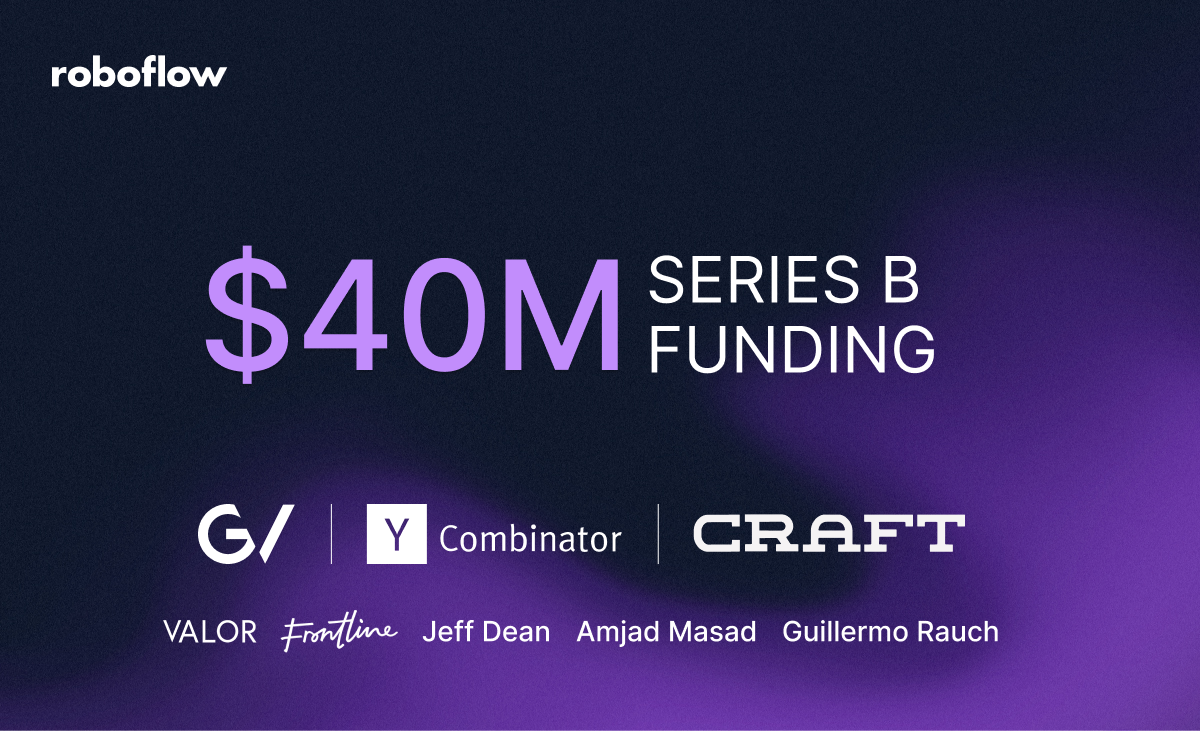
The sense of sight is fundamental to experiencing the world around us. About half of the neurons in the human cortex are related to vision. 1 And yet, the software we use everyday doesn't leverage the power of sight.
At the same time, the familiar trends that have given rise to AI — a doubling of the amount of visual data captured every year, the rapid proliferation of higher quality, open source, and increasingly multimodal models, and the improvements in hardware to run models faster and at the edge — are only accelerating.
Simply, visual AI is a platform-level shift similar in impact to the cloud and internet itself. As software eats the world, a rate limiter is the speed at which computers can understand the visual world.
At Roboflow, our mission is to make the world programmable. We’ve raised an additional $40 million to continue building the open source tools, platform, and community so developers and enterprises can deploy computer vision applications to production. GV (formerly Google Ventures) led the round, alongside existing investors Craft Ventures and Y Combinator. We’re also thrilled to welcome new investors that have a history of creating and supporting beloved software products like Guillermo Rauch, Amjad Masad, Jeff Dean, Valor, and Frontline.
Advancing the Computer Vision Ecosystem
Roboflow builds everything you need to go from raw images and video to production computer vision applications. That includes tools for dataset understanding, automated labeling, model training and finetuning, and deployment to the cloud and edge to take action. Input images or video, output understanding and actions. “Here’s an RTSP feed, email me when a package has been on my doorstep for more than 5 minutes.” Our platform is interoperable, created for builders, and always rapidly improving (please email or tweet at us feature requests).
The adoption of visual understanding is bigger than any one company, which is why it’s critical to build with and for the community. We are motivated by that community uptake. Over 1 million developers have downloaded Roboflow’s open source tools in the last 30 days alone. That includes packages like supervision (the swiss army knife of CV), inference (deploy vision models and workflows to the edge), autodistill (use foundation models to label and distill into your own models), maestro (finetune multimodal vision models).
2 Roboflow UniverseAnd yet, the state and pace of AI provides opportunities to accelerate adoption. Generative AI means leveraging pretrained models to start inference-first. Small, fast models mean using your models offline, in real time, and at the edge. Multimodality provides more context for understanding your domain problem faster. Visual agents enable creating chains of thought and sending model inference results to other systems. Spatial and temporal attention promises richer video understanding. What isn’t changing is equally important: you want your models, working on your data, connected to your systems, reliably, and quickly. Best-in-class tooling is critical.
A core reason users build with Roboflow is we ship fast and often, so you stay on top of SOTA vision advances, too. (i.e. SAM2 came out Monday 5:00 Pacific and Roboflow users were applying it on their data that Tuesday.)
Supporting Startups and Enterprises Alike
Visual understanding is a primitive that nearly every company will use. Enterprises have petabytes of underutilized visual assets. Millions of cameras are deployed globally. Billion dollar startups are being built in markets that didn’t exist five years ago thanks to computer vision. And Roboflow is proud to power them.
Market creation is already happening. One of our fast growing customers, Relo Metrics, uses computer vision to do real-time ad attribution and ROI in live broadcasts. What previously was prohibitively uneconomic — cataloging the exact seconds a logo is aired alongside showing a scoreboard during a sports broadcast — is now possible.
3Companies like Pella, one of the largest manufacturers of windows and doors in the United States, are deploying Roboflow to produce their products error free. Their CIO, Travis Turnbull, says this best: “Maintaining an innovative edge is critical to our strategy at Pella Corporation, and advancements in AI represent an unprecedented opportunity to optimize manufacturing processes and quality controls. Partnering with Roboflow has been instrumental in accelerating our learning and deployment of innovative AI solutions to achieve our goal of leading the industry in product quality and delivery for our customers." Logistics leaders like BNSF keep track of inventory and trains on the tracks with visual AI.
And because of our customers' success, Roboflow had the majority of our prior financing even when raising this most recent round.
Roboflow is free to get started and easy to scale up. We’re SOC 2 Type II compliant, support custom security rules, and power customers operating at global scale with terabytes of data today.
We Want You
Roboflow’s progress is possible because of our team. We hire those who work well with high autonomy, independent determination, and are ‘full stack people’ (those that unblock themselves to see and solve customer problems). As a result, our team is roughly ⅓ former founders, including those that have previously sold companies for 100M+ or led 100+ person engineering teams.
We have open roles across product, engineering, and go to market. If you don’t see a good role and are exceptional, we also have a wildcard role to write your own. We hire at our our offices in San Francisco, New York, Brazil, and globally distributed.
Footnotes
Cite this Post
Use the following entry to cite this post in your research:
Joseph Nelson, Brad Dwyer. (Nov 19, 2024). We Raised $40M to Invest In Enterprise and Open Source Vision AI. Roboflow Blog: https://blog.roboflow.com/series-b/
